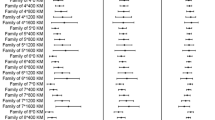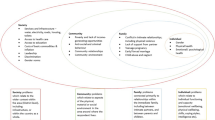Abstract
Aim
Regional variation in the prevalence of mental disorders and particularly variation in the role of risk and protective factors has received limited research attention. This study investigates variation in the prevalence of significant psychological distress across regions, and quantifies the relative impact of family functioning and social support.
Subject and method
Multilevel analysis of data from the longitudinal Australian Rural Mental Health Study, comprising a stratified random sample from non-metropolitan New South Wales. Distress was assessed using the Kessler-10. The analysis considered clustering within households and across geographic regions based on Local Government Areas and collapsed to represent residence in inner regional, outer regional, remote and very remote locations.
Results
There was limited clustering of psychological distress within areas (0.4 %). However, the household accounted for almost 45 % of the variance in psychological distress, and the salience of the household was greater in more remote regions (33.1 % in inner regional to 60.5 % in very remote areas). Family functioning and perceived social support were associated with increased risk of psychological distress, but explained only a modest amount of variance in mental health at household level. After controlling for individual and family/social covariates, 34.5 % of the remaining variance in psychological distress was observed at the household level.
Conclusion
The findings suggest that individuals in remote locations are more reliant on their family/confidants for their mental health than those in more populated areas. Future research will consider whether this simply reflects differences in the accessibility of formal health services or broader social and cultural differences.
Similar content being viewed by others
References
Banks E, Redman S, Jorm L, Armstrong B, Bauman A, Beard J, Beral V, Byles J, Corbett S, Cumming R, Harris M, Sitas F, Smith W, Taylor L, Wutzke S, Lujic S (2008) Cohort profile: the 45 and up study. Int J Epidemiol 37:941–947. doi:10.1093/ije/dym184
Browne WJ (2012) MCMC estimation in MLwiN. Centre for Multilevel Modelling, University of Bristol, Bristol, UK
Brugha TS, Cragg D (1990) The list of threatening experiences: the reliability and validity of a brief life events questionnaire. Acta Psychiatr Scand 82:77–81. doi:10.1111/j.1600-0447.1990.tb01360.x
Butterworth P, Rodgers B, Jorm AF (2006) Examining geographical and household variation in mental health in Australia. Aust N Z J Psychiatr 40:491–497. doi:10.1080/j.1440-1614.2006.01827.x
Butterworth P, Leach LS, Olesen SC (2012) Mental health in the suburbs: an investigation of differences in the prevalence of depression across Canberra suburbs using data from the PATH Through Life Study. J Public Health 20:525–531. doi:10.1007/s10389-011-0482-7
Diez-Roux AV (2000) Multilevel analysis in public health research. Annu Rev Public Health 21:171–192. doi:10.1146/annurev.publhealth.21.1.171
Galea S, Tracy M (2007) Participation rates in epidemiologic studies. Ann Epidemiol 17:643–653. doi:10.1016/j.annepidem.2007.03.013
Henderson S, Duncan-Jones P, Byrne DG, Scott R (1980) Measuring social relationships: The Interview Schedule for Social Interaction. Psychol Med 10:723–734. doi:10.1017/S003329170005501X
Hosmer DW, Lemeshow S (2000) Applied logistic regression. Wiley, New York
Judd F, Jackson H, Komiti A, Murray G, Fraser C, Grieve A, Gomez R (2006) Help-seeking by rural residents for mental health problems: the importance of agrarian values. Aust N Z J Psychiatr 40:769–776. doi:10.1080/j.1440-1614.2006.01882.x
Kelly BJ, Stain HJ, Coleman C, Perkins D, Fragar L, Fuller J, Lewin TJ, Lyle D, Carr VJ, Wilson JM, Beard JR (2010) Mental health and well-being within rural communities: the Australian rural mental health study. Aust J Rural Health 18:16–24. doi:10.1111/j.1440-1584.2009.01118.x
Kelly BJ, Lewin TJ, Stain HJ, Coleman C, Fitzgerald M, Perkins D, Carr VJ, Fragar L, Fuller J, Lyle D, Beard JR (2011) Determinants of mental health and well-being within rural and remote communities. Soc Psychiatry Psychiatr Epidemiol 46:1331–1342. doi:10.1007/s00127-010-0305-0
Kessler RC, Andrews G, Colpe LJ, Hiripi E, Mrockzek DK, Normand S-LT, Walters EE, Zaslavsky AM (2002) Short screening scales to monitor population prevalences and trends in non-specific psychological distress. Psychol Med 32:959–976. doi:10.1017/S0033291702006074
Komiti A, Judd F, Jackson H (2006) The influence of stigma and attitudes on seeking help from a GP for mental health problems: a rural context. Soc Psychiatry Psychiatr Epidemiol 41:738–745. doi:10.1007/s00127-006-0089-4
Murray G, Judd F, Jackson H, Fraser C, Komiti A, Hodgins G, Pattison P, Humphreys J, Robins G (2004) Rurality and mental health: the role of accessibility. Aust NZ J Psychiatr 38:629–634. doi:10.1111/j.1440-1614.2004.01426.x
Rai D, Zitko P, Jones K, Lynch J, Araya R (2013) Country- and individual-level socioeconomic determinants of depression: multilevel cross-national comparison. Br J Psychiatry 202:195–203. doi:10.1192/bjp.bp.112.112482
Rasbash J, Steele F, Browne WJ, Goldstein H (2012) A user’s guide to MLwiN, Centre for multilevel modelling, University of Bristol, Bristol, UK
Slade T, Grove R, Burgess P (2011) Kessler psychological distress scale: normative data from the 2007 Australian national survey of mental health and wellbeing. Aust NZ J Psychiatr 45:308–316. doi:10.3109/00048674.2010.543653
Smith KB, Humphreys JS, Wilson MGA (2008) Addressing the health disadvantage of rural populations: how does epidemiological evidence inform rural health policies and research? Aust J Rural Health 16:56–66. doi:10.1111/j.1440-1584.2008.00953.x
Snijders TAB, Bosker RJ (2004) Multilevel analysis: an introduction to basic and advanced multilevel modelling. Sage, London
Spiegelhalter DJ, Best NG, Carlin BP, van der Linde A (2002) Bayesian measures of model complexity and fit (with discussion). J R Stat Soc Ser B 64:583–639
Weich S (2005) Absence of spatial variation in rates of the common mental disorders. J Epidemiol Community Health 59:254–257. doi:10.1136/jech.2004.027797
Weich S, Holt G, Twigg L, Jones K, Lewis G (2003) Geographic variation in the prevalence of common mental disorders in Britain: a multilevel investigation. Am J Epidemiol 157:730–737. doi:10.1093/aje/kwg035
Welton NJ, Sutton AJ, Cooper NJ, Abrams KR, Ades AE (2012) Evidence synthesis for decision making in healthcare. Wiley, New York
Acknowledgements
We wish to recognise the contribution of the ARMHS chief investigators: Prof David Lyle, A/Prof David Perkins, A/Prof Lyn Fragar, Prof John Beard, Prof Vaughan Carr, Prof Jeffrey Fuller, A/Prof Helen Stain and Senior Project Co-ordinator Dr Clare Coleman. The study was funded by the National Health and Medical Research Council (Project Grants No. 401241; No. 631061), and also supported by a Research Capacity Building Grant to the Australian Rural Health Research Collaboration. We wish to acknowledge the support of Directors of Mental Health Services in the respective Local Health Districts over the course of the study: Dr Russell Roberts, Richard Buss, Martin Cohen, Dinesh Arya and particularly acknowledge the research site coordinators in each site: Jan Sidford, John Ogle (Broken Hill), Trim Munro, Amy Strachan (Moree), Louise Holdsworth, Kath O’Driscoll (Lismore), Cheryl Bennett, Jannelle Bowler (Orange), along with Fleur Hourihan, Dr Gina Sartore, and Denika Novello.
Conflict of interest
The authors declare that they have no conflict of interest.
Author information
Authors and Affiliations
Corresponding author
Rights and permissions
About this article
Cite this article
Butterworth, P., Handley, T.E., Lewin, T.J. et al. Psychological distress in rural Australia: regional variation and the role of family functioning and social support. J Public Health 22, 481–488 (2014). https://doi.org/10.1007/s10389-014-0640-9
Received:
Accepted:
Published:
Issue Date:
DOI: https://doi.org/10.1007/s10389-014-0640-9




